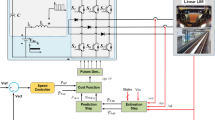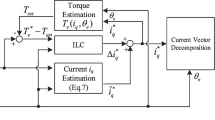Abstract
This paper presents a nonlinear control structure for variable-speed squirrel cage induction generator-based wind energy conversion systems. The proposed control structure consists of two control systems designed for machine side converter (MSC) and grid side converter (GSC). The MSC controller is based on adaptive input–output feedback linearization designed in a new reference frame and is responsible for controlling the flux and torque of the machine. Torque control is achieved through a PI controller that its output determines the speed of the presented reference frame at each moment. For the GSC, a sliding mode-based control system is designed to control the DC link voltage in addition to controlling the active and reactive power exchanged with the grid. The validity and effectiveness of the proposed control structure have been investigated through simulation studies in MATLAB® software environment.






Similar content being viewed by others

Abbreviations
- GSC:
-
Grid side converter
- IOFL:
-
Input–output feedback linearization
- MSC:
-
Machine side converter
- SMC:
-
Sliding mode control
- SCIG:
-
Squirrel-cage induction generator
- WECS:
-
Wind energy conversion system
- \({{\omega }_{\mathrm {r}}}\) :
-
Rotor shaft mechanical speed
- \({{\omega }_{e}}, {{\omega }_{ev}}\) :
-
Rotational speed of synchronous qd and xy reference frames
- \({{\theta }_{e}}, {{\theta }_{ev}}\) :
-
Angular position of synchronous qd and xy reference frames
- \({T}_{\mathrm {m}}, {T}_{\mathrm {e}}\) :
-
Mechanical, electromagnetic torques
- \({P}_{\mathrm {s}}, {Q}_{\mathrm {s}}\) :
-
Stator active and reactive power
- \({P}_{\mathrm {g}}, {Q}_{\mathrm {g}}\) :
-
Grid active and reactive power
- \({V}_{\mathrm {dc}}, {I}_{\mathrm {dc}}\) :
-
DC link voltage and current
- J :
-
Lumped inertia momentum
- D :
-
Lumped damping factor
- \({{R}_{\mathrm {s}}}, {{R}_{\mathrm {r}}}\) :
-
Stator, rotor resistances
- \({{L}_{\mathrm {s}}}, {{L}_{\mathrm {r}}}\) :
-
Stator, rotor inductances
- \({{L}_{\mathrm {m}}}\) :
-
Magnetizing inductance
- \({{\sigma }}\) :
-
Leakage factor
- P :
-
Pole pairs
- \({{\lambda }_{sqd}}, {{\lambda }_{sxy}}\) :
-
Stator flux linkage in qd and xy frames
- \({{I}_{sqd}}, {{I}_{sxy}}\) :
-
Stator current in qd and xy frames
- \({{V}_{sqd}}, {{V}_{sxy}}\) :
-
Stator voltage in qd and xy frames
- \({{V}_{iqd}}, {{V}_{ixy}}\) :
-
Inverter voltage in qd and xy frames
- \({{V}_{gqd}}, {{I}_{gxy}}\) :
-
Grid voltage and current in qd frames
- \({{V_{1,2}}}\) :
-
Lyapunov function
- \({{S}_{qd}}\) :
-
Sliding surface
- \({{\hat{R}}_{\mathrm {s}}}\) :
-
Estimated stator resistance
- \({{\tilde{R}}_{\mathrm {s}}}\) :
-
Stator resistance estimation error
- e :
-
Tracking error
- k :
-
Control gain
- \({\gamma }\) :
-
Estimation gain
References
Aguemon, D. P., Agbokpanzo, R. G., Dubas, F., Vianou, A., Chamagne, D., & Espanet, C. (2020). A comprehensive analysis and review on electrical machines in wind energy conversion systems. In Advanced engineering forum (Vol. 35, pp. 77–93). Trans Tech Publications Ltd.
Ahmed, M. M., Hassanein, W. S., & Enany, M. A. (2020). Proposing and evaluation of SC techniques for variable speed high-power operation of SEIG. IEEE Access, 8, 20666–20675.
Atallah, A. M., & El Sayed, F. (2015). Direct torque control of machine side multilevel converter for variable speed wind turbines. Energy, 90, 1091–1099.
Boulouiha, H. M., Allali, A., & Denai, M. (2017). Grid integration of wind energy systems: Control design, stability, and power quality issues. In Clean energy for sustainable development (pp. 239–335). Academic Press.
Boulouiha, H. M., Allali, A., Laouer, M., Tahri, A., Denai, M., & Draou, A. (2015). Direct torque control of multilevel SVPWM inverter in variable speed SCIG-based wind energy conversion system. Renewable Energy, 80, 140–152.
Chauhan, P. J., & Chatterjee, J. K. (2018). A novel speed adaptive stator current compensator for voltage and frequency control of standalone seig feeding three-phase four-wire system. IEEE Transactions on Sustainable Energy, 10(1), 248–256.
de Azevedo, I. A., Barros, L. S., & Cunha, C. D. (2019). Model reference adaptive control for squirrel-cage induction generator-based wind energy conversion systems.
Dewangan, S., & Vadhera, S. (2020). Performance enhancement of a stand-alone induction generator-based wind energy system using neural network controller. International Journal of Green Energy, 17(4), 274–289.
Fateh, F., White, W. N., & Gruenbacher, D. (2015). A maximum power tracking technique for grid-connected DFIG-based wind turbines. IEEE Journal of Emerging and Selected Topics in Power Electronics., 3(4), 957–966.
Fouad, K., Boulouiha, H. M., Allali, A., Taibi, A., & Denai, M. (2018). Multivariable control of a grid-connected wind energy conversion system with power quality enhancement. Energy Systems, 9(1), 25–57.
Gupta, N., & Nama, J. K. (2019). An experimental investigation of scalar control-based induction motor drive using digital signal processor. International Journal of Power Electronics, 10(1–2), 102–132.
Hossain, J., & Pota, H. R. (2014). Robust control for grid voltage stability: High penetration of renewable energy. In Power systems: Springer.
Ion, C. P., & Serban, I. (2019). Seamless Integration of an Autonomous Induction Generator System into an Inverter-based microgrid. Energies, 12(4), 638.
Kamarzarrin, M., & Refan, M. H. (2020). Intelligent sliding mode adaptive controller design for wind turbine pitch control system using PSO-SVM in presence of disturbance. Journal of Control, Automation and Electrical Systems, 31, 1–14.
Kenne, G., Sanjong, C. T., Fotso, A. S., & Nfah, E. M. (2018). A robust control strategy for a self-excited induction generator wind turbine system. International Journal of Dynamics and Control, 6(1), 300–318.
Krause, P., Wasynczuk, O., Sudhoff, S. D., & Pekarek, S. (2013). Analysis of electric machinery and drive systems. New York: Wiley.
Kumar, M. B. H., Saravanan, B., Sanjeevikumar, P., & Blaabjerg, F. (2018). Review on control techniques and methodologies for maximum power extraction from wind energy systems. IET Renewable Power Generation, 12(14), 1609–1622.
Lin, F. J., Tan, K. H., Fang, D. Y., & Lee, Y. D. (2013). Intelligent controlled three-phase squirrel-cage induction generator system using wavelet fuzzy neural network for wind power. IET Renewable Power Generation, 7(5), 552–564.
Liu, J., Meng, H., Hu, Y., Lin, Z., & Wang, W. (2015). A novel MPPT method for enhancing energy conversion efficiency taking power smoothing into account. Energy Conversion and Management, 101, 738–748.
Lunardi, A. S., Chaves, J. S., & Sguarezi Filho, A. J. (2016). Predictive direct torque control for a squirrel cage induction generator grid connected for wind energy applications. IEEE Latin America Transactions, 14(11), 4454–4461.
Merabet Boulouiha, H., Khodja, M., Rahiel, D., Allali, A., Kaddour, F., & Denai, M. (2019). Power quality enhancement in electricity grids with wind energy using multicell converters and energy storage. Journal of Renewable and Sustainable Energy, 11(1), 013302.
Mesemanolis, A., Mademlis, C., & Kioskeridis, I. (2012). High-efficiency control for a wind energy conversion system with induction generator. IEEE Transactions on Energy Conversion, 27(4), 958–967.
Nasiri, M., Milimonfared, J., & Fathi, S. H. (2014). Modeling, analysis and comparison of TSR and OTC methods for MPPT and power smoothing in permanent magnet synchronous generator-based wind turbines. Energy Conversion and Management, 86, 892–900.
Ohiero, P. O. (2015). Development of fast multi-system simulation models for permanent magnet synchronous motor and generator drive systems. Doctoral dissertation. University of Glasgow.
Ourhdir, R., & Rachidi, M. (2019). Adaptive input-output feedback linearization control of doubly-fed induction machine in wind power generation. International Review of Automatic Control, 12(1), 11–20.
Rezaei, M. M. (2018). A nonlinear maximum power point tracking technique for DFIG-based wind energy conversion systems. Engineering Science and Technology, An International Journal, 21(5), 901–908.
Rezaei, M. M., & Mirsalim, M. (2010). Improved direct torque control for induction machine drives based on fuzzy sector theory. Iranian Journal of Electrical & Electronic Engineering, 6(2), 110–118.
Rezaei, M. M., & Soltani, J. (2015). Robust control of an islanded multi-bus microgrid based on input-output feedback linearisation and sliding mode control. IET Generation, Transmission and Distribution, 9(15), 2447–2454.
Rezaei, M. M., & Soltani, J. (2016). Sliding mode control of a grid-connected distributed generation unit under unbalanced voltage conditions. Automatika, 57(1), 89–98.
Sguarezi Filho, A. J., Solís-Chaves, J. S., de Almeida, L. A. L., Costa, F. F., Casella, I. R. S., & Capovilla, C. E. (2019). A wireless OFDM control system of SCIG for applications in smart grids jointly employing convolutional coding and FWMA filtering. Journal of Control, Automation and Electrical Systems, 30(3), 360–370.
Shiraliyan, M., Sharma, P., & Sharma, C. (2018). Automatic reactive power control of isolated wind-diesel hybrid power system using artificial bee colony and gray wolf optimization. International Journal of Green Energy, 15(14–15), 889–904.
Simo Fotso, A., Kenné, G., & Douanla, R. M. (2019). A simple flexible and robust control strategy for wind energy conversion systems connected to a utility grid. Journal of Control Science and Engineering, 2019, 5032694. https://doi.org/10.1155/2019/5032694.
Slotine, J. J., & Li, W. (1991). Applied nonlinear control. Englewood Cliffs, NJ: Prentice Hall.
Sohn, A. P., Salles, M. B. D. C., & Alberto, L. F. (2019). Transient stability of power systems under high penetrations of wind power generation. Journal of Control, Automation and Electrical Systems, 30(6), 1116–1125.
Stefan, F., Böttcher, H., Gusti, M., Havlík, P., Klaassen, G., Kindermann, G., et al. (2016). Dynamics of the land use, land use change, and forestry sink in the European Union: the impacts of energy and climate targets for 2030. Climatic Change, 138(1–2), 253–266.
Tanvir, A. A., & Merabet, A. (2020). Artificial neural network and kalman filter for estimation and control in standalone induction generator wind energy DC microgrid. Energies, 13(7), 1743.
Vaidyanathan, S., & Azar, A. T. (Eds.). (2020). Backstepping control of nonlinear dynamical systems. New York: Academic Press.
Zaky, M. S., & Metwaly, M. K. (2016). A performance investigation of a four-switch three-phase inverter-fed IM drives at low speeds using fuzzy logic and PI controllers. IEEE Transactions on Power Electronics, 32(5), 3741–3753.
Zeb, K., Ali, Z., Saleem, K., Uddin, W., Javed, M. A., & Christofides, N. (2017). Indirect field-oriented control of induction motor drive based on adaptive fuzzy logic controller. Electrical Engineering, 99(3), 803–815.
Zribi, M., Alrifai, M., & Rayan, M. (2017). Sliding mode control of a variable-speed wind energy conversion system using a squirrel cage induction generator. Energies, 10(5), 604.
Author information
Authors and Affiliations
Contributions
AS contributed to methodology and software. JS was involved in the conceptualization and methodology. MMR was involved in the supervision, investigation and validation.
Corresponding author
Ethics declarations
Conflict of interest
The authors declare that they have no known competing financial interests or personal relationships that could have appeared to influence the work reported in this paper.
Additional information
Publisher's Note
Springer Nature remains neutral with regard to jurisdictional claims in published maps and institutional affiliations.
Rights and permissions
About this article
Cite this article
Sotoudeh, A., Soltani, J. & Rezaei, M.M. A Robust Control for SCIG-Based Wind Energy Conversion Systems Based on Nonlinear Control Methods. J Control Autom Electr Syst 32, 735–746 (2021). https://doi.org/10.1007/s40313-021-00705-0
Received:
Revised:
Accepted:
Published:
Issue Date:
DOI: https://doi.org/10.1007/s40313-021-00705-0



